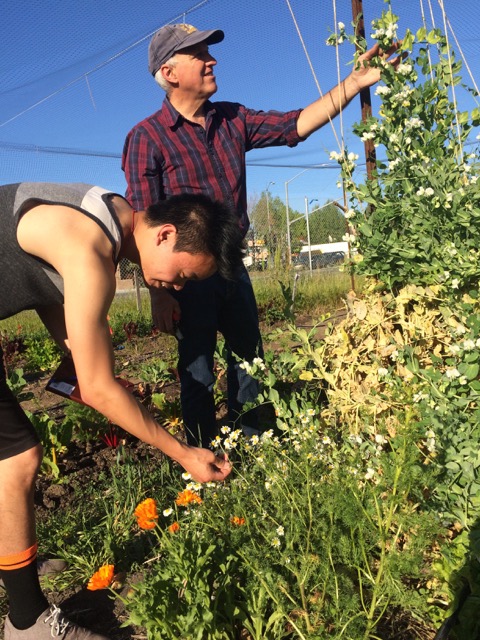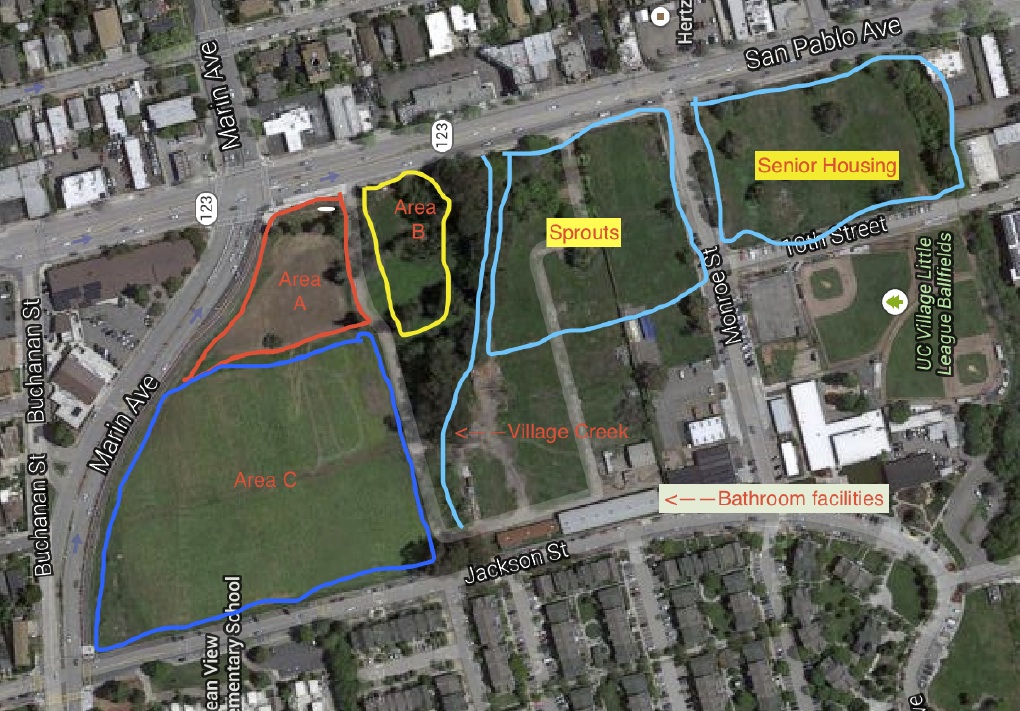
Integrative biology associate teaching professor Thomas Carlson, a collaborator on Berkeley Food Insitute research grant for the UC Gill Tract Community Farm, studies plants grown on the farm with undergraduate researcher Jake Wu, who is conducing research on the farm through the Undergraduate Research Apprenticeship Program. PHOTO: Jennifer Sowerwine
Roughly 14,000 pounds of food have been produced and distributed by the farm located on the University of California–owned Gill Tract in Albany since the start of an ambitious town-gown collaboration one year ago, which launched with a family planting day on Earth Day 2014. Several small grants now support its research, education and outreach goals, and it has built relationships with local food pantries, K–12 schools, and community organizations as far flung as the Jewish Community Center and Filipinos4Justice. The fledging enterprise even has an official name: The UC Gill Tract Community Farm.
As the project marks its one-year anniversary this Earth Day 2015 (April 22) with hands-on learning today and a pot-luck celebration on Saturday, people from both UC and the community say there have been enormous strides on the once-contentious plot of land at the corner of Marin and San Pablo Avenues.
“We are working hard with both UC and community members to develop a ‘lighthouse’ style farm for urban agriculture,” said Jennifer Sowerwine, assistant Cooperative Extension (CE) specialist based at UC Berkeley’s College of Natural Resources (CNR). “That means participants are invited to ‘come, learn, and take away’— returning to their own communities to share the fruits of our research and education programs.”
Toward that end, much progress has already been made. Sowerwine and her CE colleague Christy Getz secured a three-year U.S. Department of Agriculture grant to run a workshop series on ecological farming methods and food safety—designating the farm as one of five Bay Area “agricultural learning hubs.” Two half-time positions—a farm manager and community liaison, funded by CNR and grants—bring some continuity and stability.
Seasonal reports quantify the farm’s busy schedule, including food distribution to soup kitchens and homeless shelters, numerous free workshops from composting to Spanish-language organic gardening, and hosting tours for scientists, academics and civic organizations from several states and nearly a dozen countries.
John Hoffman, the farm manager, enthusiastically reels off more recent activities not yet cataloged. For example, Philadelphia's North Philly Community Garden, a politically complex project on the edge of a blighted neighborhood, was interested in the governance issues, and the Emeryville-based Center for Neuroskills, a residential treatment program for people with brain injuries, sent volunteers to work the farm as part of their recovery process. “It’s just a huge range of people who’ve reached out to us,” he said.
Future plans include basing local 4-H and Master Gardener groups here—both UC programs—and successful grant applications would fully realize the lighthouse concept with a full slate of demonstrations, experimental plots, lecture series, and shared learning activities.
Collecting Data
Research is also a central enterprise. In addition to the farm’s focus on learning what crops grow best in the local microclimate and in drought conditions, data is collected on volunteer hours, produce yield, agroecological techniques, and the diverse demographics of the volunteers. A seed grant from Berkeley Food Institute is supporting research into the diversity of ethnic foods being grown in the East Bay, a project that engages 11 UC Berkeley undergraduate interns and one graduate student.

The UC Gill Tract Community Farm is located in Area A.
Environmental Science junior Deborah S. Yang was interested in food systems and snagged a communications internship through CNR’s SPUR program—Sponsored Projects for Undergraduate Research. She fielded language surveys, ran the website, and identified key issues among the farm’s diverse stakeholders, among other duties. Those early days weren’t always pretty, she said. Tensions sometimes ran high. Parliamentary procedure wasn’t always followed. “It was hard to make much progress because everyone had different opinions and because the official rules of governance hadn't been decided [yet].”
But despite those weaknesses, Yang said the experience “opened up my mind to social issues and injustices that I was not aware of before, such as in the LGTBQ community, the Ohlones, and many economically struggling minority communities in the East Bay. This is something that you can't learn in the classroom.” It caused her to reevaluate some assumptions gleaned from her conservative upbringing, she said. “Unless you actually go talk to someone from a different background and work with them for 8 hours to weed, dig, and spread compost over a 20 foot–long row, it's really hard to apply what you might learn in a sociology class to real life.”
Yang hopes to return to the farm to conduct her required year-long senior research project next semester.
A Pioneering Collaborative Partnership
While the farm slowly grows into a research and learning hub, the University- community partnership has been an innovative experiment in its own right; exploring how university and community groups can, according to Sowerwine, “authentically collaborate to achieve a common vision.”
There are now working groups in research, education and events, outreach, fundraising, and farm management. A Stewardship Council, comprising UC faculty, students, staff, and community members, has served as a decision-making body, and those decisions are ratified by a broader Stewardship Assembly.
“We’re really breaking new ground,” said Hoffman, who worked on community farms in New York and San Francisco before running a company that served healthy meals to Bay Area schools for 32 years. His involvement started with the 2012 protests on the site, but he now lauds the collaboration. “UC has a lot to be proud of—they’ve really been pioneers. In the beginning we tried to find examples of collaboratives like ours, between universities and communities, but we weren’t able to find anything,” Inventing the process themselves is why it took the group more than a year to get solid, functioning governance in place, he said.
“The ‘proto-Stewardship Council’ has now become ‘the Stewardship Council.’ That’s huge progress for us,” Sowerwine adds.
Some activists are taking issue with a senior housing development and retail market development approved by the city of Albany to be built on an adjacent plot of land that was home to decrepit university housing, now demolished. But those plans are for an area south of Village Creek, not for the agricultural areas—so that project has no impact on the UC-GT Community Farm (see map, Area A).
“The University is committed to the UC Gill Tract Community Farm project for as long as community interest continues, and this past year has shown that the commitment is genuine,“ said CNR Dean J. Keith Gilless. CNR supports the farm through land, water, and dedicated time from two CE specialists and a new faculty position in sociology of agriculture. “The prospects are exciting, and understanding community-based and water-conscious farming issues couldn’t be more relevant for our College.”
RELATED
- UC-Gill Tract Farm Earth Day Events
- Earth Day 2014
- First University-Community Gill Tract event seeks unity, vision
